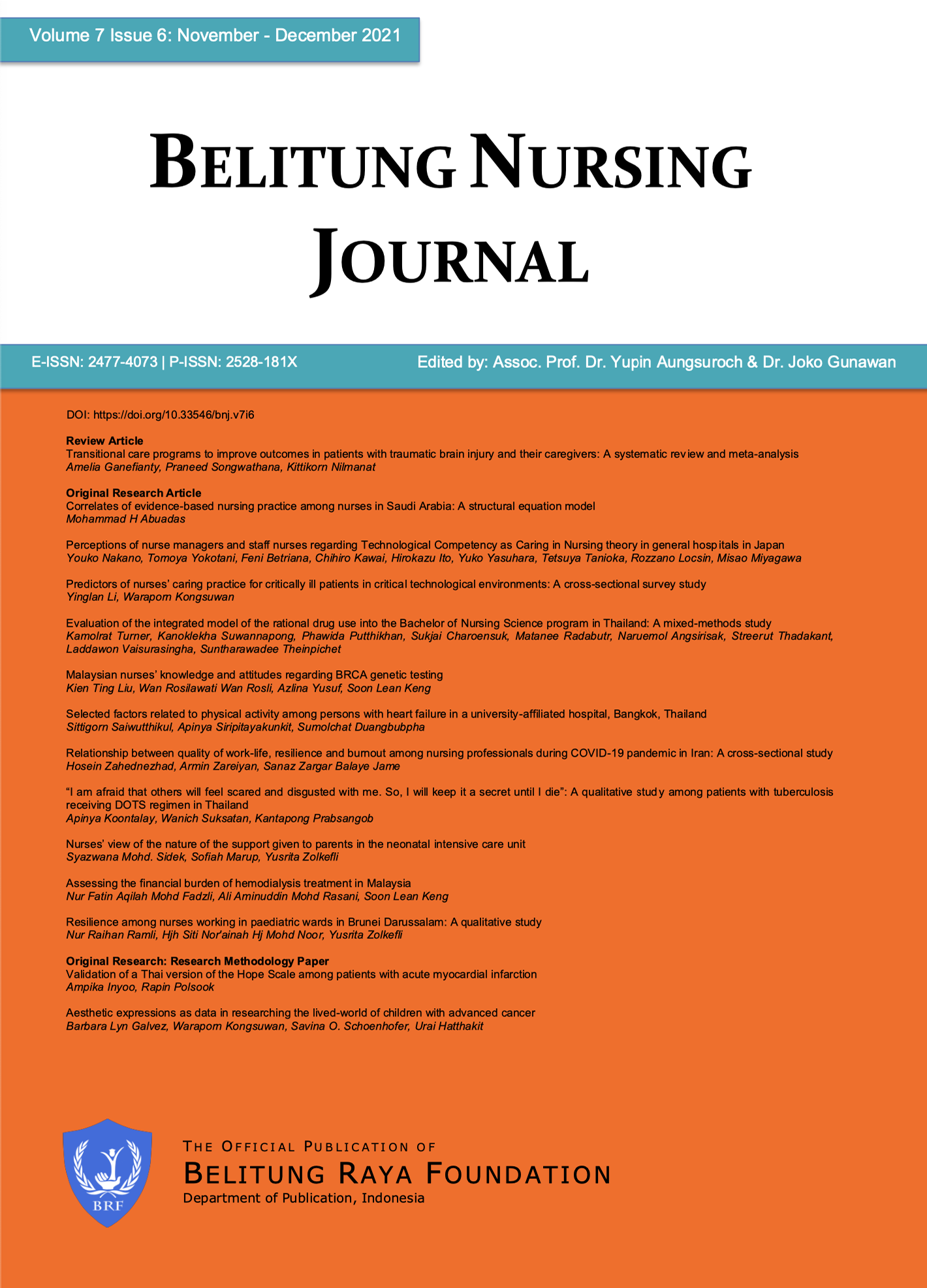Breast cancer (BC) is widely recognised as a significant public health concern and the leading cause of cancer-related death globally. In 2020, 2.3 million women were diagnosed with BC, with 685,000 fatalities worldwide (World Health Organization, 2020a). Furthermore, there is an increasing trend of BC incidents (8.3%) and mortality (9.3%) between 2018 and 2020 among females worldwide (Ferlay et al., 2015; World Health Organization, 2020b). BC is also the most commonly diagnosed cancer in Malaysia, accounting for 7593 new cases reported among females in 2018 and 8418 in 2020 (World Health Organization, 2020a). Genetic testing expands across medical specialities and is increasingly ordered and managed by non-geneticists (Blazer et al., 2011). For example, the BRCA genetic testing is a blood test that uses DNA analysis to identify harmful changes (mutations) in either breast cancer susceptibility genes – Breast Cancer gene 1 (BRCA1) and Breast Cancer gene 2 (BRCA2). Linking breast and ovarian cancer were mutations in the BRCA1 and BRCA2 genes (Nelson et al., 2014).
Knowledge of an individual’s gene mutation status may allow for proactive medical management, including enhanced attitudes regarding screening and prophylactic surgical or medical interventions for cancer risk reduction and treatment (Bellcross et al., 2011; Blazer et al., 2011; Dhar et al., 2011). Understanding cancer risk can help healthy individuals make health care decisions, such as attending a regular screening or opting for surgery, to help reduce cancer risk. In addition, genetic testing for risk can help women make important decisions about prevention or early detection (Bellcross et al., 2011; Blazer et al., 2011; Dhar et al., 2011).
Nurses play a critical part in the multidisciplinary healthcare team that treats and manage patients with breast cancer. These nurses can help communities improve women’s health by providing education and increased awareness of BRCA genetic testing and breast and ovarian cancer screening. As primary care providers, nurses are instrumental in identifying and referring women for BRCA genetic testing. Within the nursing profession, BC is a significant problem for health promotion and cancer prevention. Primary care providers, such as nurses, are vital parts of the healthcare team. Thus, they are responsible for identifying and referring women for testing (Smania, 2016). Several surveys assessed knowledge and attitudes towards BRCA genetic testing; however, these are on medical students and physicians (Keating et al., 2008; Pal et al., 2013; Cohn et al., 2015).
A literature search conducted using different combinations of keywords show no existing literature on the topic or the same research idea closely related topics on nurses’ knowledge and attitude regarding BRCA genetic testing for breast and ovarian cancer risk. In addition, it is unclear what knowledge nurses have during nursing training about BRCA gene testing for breast and ovarian cancer risk. Therefore, to decrease this gap, this survey aimed to assess the knowledge and attitude of Malaysian nurses regarding BRCA gene testing for breast and ovarian cancer risk.
Methods
Study Design
The study utilised a descriptive cross-sectional study at Hospital USM located in northeast peninsular Malaysia because it is a reference public and tertiary teaching hospital. Kelantan is one of Peninsular Malaysia's rural states, with women accounting for half of the population (1.7 million) and Malays make about 95% of the population (Muhamad et al., 2012).
Participants
The study involved nurses from this tertiary teaching hospital’s medical and surgical wards and oncology, paediatric, obstetrics, and gynaecology departments. Nurses were excluded if they declined to participate in the study or could not be reached for various reasons, such as annual leave, vacation, maternity leave, or sick leave. The sample size was determined based on a study of Escher and Sappino (2000) using the G*Power 3.1.9.2 software (Faul et al., 2007) by considering 95% of confidence interval (CI), 5% margin of error, ⍺=0.05, a study power of 80 and non-response rate 10%, the final sample size of the study becomes 160. After proportional allocation within the five working units, a simple random sampling technique was used to reach the study participants.
Measures
Data collection utilised a self-administered questionnaire. The questionnaire consisted of three parts. Part I consists of socio-demographic data such as age, gender, ethnicity, nursing education level, years of experience and speciality working area.
Part II consists of ten items’ True-False’ scale based on the National Health Interview Survey (NHIS) (National Center for Health Statistics, 2010) to assess the participant’s knowledge on BRCA1 and BRCA2 genetic testing. For the knowledge section, every correct answer was assigned one point and incorrect response zero points. The expected knowledge score was between 0 to 10 points. The internal consistency coefficient (Cronbach’s α) for knowledge for BRCA genetic testing was 0.78, considered a good reliability value. The scores for knowledge and attitude were transformed into percentage scores. Each outcome’s sum score was then assessed based on Bloom’s cut off point (Bloom, 1956). Those participants who obtained knowledge scores seven and above were considered high level, while scores between 4 to 6 were considered moderate level. The score three and below was considered as low level.
Part III comprises ten items on attitudes towards breast-ovarian cancer genetic testing. The researchers prepared the questionnaires based on literature and checked by a panel of experts (an oncologist, a breast and endocrine consultant, and a medical statistician). In this part, each item was scored on a 5-point Likert scale, ranging from ‘strongly agree’ to ‘strongly disagree’ and categorised into strongly positive to strongly negative. In medical education and research, Likert scales are commonly employed (Sullivan & Artino Jr, 2013). The results for attitude were divided into four categories: strongly positive (41-50), positive (31-40), negative (21-30), and strongly negative (10-20).
Data Collection
Data collection commenced from early January until the end of February 2016. A structured self-administered questionnaire in English was used to collect data. In determining questionnaires appropriateness and ethical soundness, pretesting the questionnaire was done with 5% of the sample size among nurses who did not form part of the study participants. The researchers distributed the questionnaire to participants individually after shift duty and checked all filled questionnaires for completeness. Permission to utilise the NHIS questionnaires are in the public domain, and no consent is required to use them.
Data Analysis
The data was entered into the Windows version 23 of the Statistical Package for Social Sciences (SPSS). In terms of pertinent factors, descriptive statistics (means, standard deviations, frequencies, and percentages) defined the study population. The Kolmogorov Smirnov test was used to determine whether the data was suitable for normal distribution. The Fisher exact test was used to assess the association between socio-demographic variables (age group, gender, ethnicity, highest nursing degree, years of experience, specialised working area, and years of working experience) and knowledge and attitude level. In all variables, a p-value ≤ of 0.05 was considered as significantly associated with the outcome variable.
Ethical Considerations
The Human Research Ethics Committee USM (Reference No: USM/JEPeM/15100409) approved the study. The participants’ written informed consent was obtained following the Declaration of Helsinki and the institutional requirements. In maintaining anonymity and confidentiality, coded numbers were used during data collection.
Results
The study included 150 nurses, with a response rate of 93.8%. Nurses’ mean age was 28.9 years (SD = 6.70). The majority of the participants were female (96%) and Malay (89.3%). The mean work experience was 7.05 (SD = 6.16) years, and more than three-quarters of the participants (88.0%) were diploma holders. Less than half of the participants (37.3%) worked in the oncology unit, while 28.7% worked in the medical unit. The remainder participants worked in surgical (17.3%), obstetrics and gynaecology (14.0%) and paediatric (2.7%) units (Table 1).
| Variables | Mean (SD) | n | % |
|---|---|---|---|
| Age | 28.85 (6.70) | ||
| Gender | |||
| Male | 6 | 4.0 | |
| Female | 144 | 96.0 | |
| Ethnicity | |||
| Malay | 134 | 89.3 | |
| Non-Malay | 16 | 10.7 | |
| Highest nursing education | |||
| Diploma | 132 | 88.0 | |
| Diploma and post-basic | 9 | 6.0 | |
| Diploma, post-basic and degree | 9 | 6.0 | |
| Year of working experience | 7.05 (6.16) | ||
| Speciality of working area | |||
| Medical | 43 | 28.7 | |
| Surgical | 26 | 17.3 | |
| Oncology | 56 | 37.3 | |
| Obstetrics and gynaecology | 21 | 14.0 | |
| Paediatric | 4 | 2.7 |
Table 2 showed that the association of socio-demographic characteristics and knowledge level of nurses of BRCA genetic testing. The majority of the participants (66.7%) had high knowledge about BRCA gene testing, while 25.3 had a moderate level of knowledge. Only 8% of the participants had a low level of knowledge score. Years of experience and nurses’ knowledge of BRCA genetic testing were statistically significant (p = 0.014) when examined using the Fisher exact test. When compared to junior nurses, senior nurses with 21-30 years of experience had higher knowledge. No significant association was found between the following variables: age group (p = 0.235), gender (p = 0.110), ethnicity (p >0.950), nursing education level (p = 0.249), and speciality of work area (p = 0.123).
| Variables | Knowledge level, n (%) | p valuea | ||
|---|---|---|---|---|
| High | Moderate | Low | ||
| Knowledge level | 100 (66.7) | 38 (25.3) | 12 (8.0) | |
| Age group, years | 0.235a | |||
| 20-30 | 76 (71.0) | 22 (20.6) | 9 (8.4) | |
| 31-40 | 18 (56.3) | 11 (34.4) | 3 (9.4) | |
| 41-50 | 6 (60.0) | 4 (40.0) | 0 (0.0) | |
| 51-60 | 0 (0.0) | 1 (100.0) | 0 (0.0) | |
| Gender | 0.110a | |||
| Male | 3 (50.0) | 1 (16.7) | 2 (33.3) | |
| Female | 97 (67.4) | 37 (25.7) | 10 (6.9) | |
| Ethnicity | >0.950a | |||
| Malay | 89 (66.4) | 34 (25.4) | 11 (8.2) | |
| Non-Malay | 11 (68.8) | 4 (25.0) | 1 (6.3) | |
| Nursing education level | 0.249a | |||
| Diploma | 90 (68.2) | 30 (22.7) | 12 (9.1) | |
| Diploma & post basic | 4 (44.4) | 5 (55.6) | 0 (0.0) | |
| Diploma, post basic & degree | 6 (66.7) | 3 (33.3) | 0 (0.0) | |
| Speciality of work area | 0.123a | |||
| Medical | 32 (74.4) | 8 (18.6) | 3 (7.0) | |
| Surgical | 21 (80.8) | 3 (11.5) | 2 (7.7) | |
| Oncology | 30 (53.6) | 22 (39.3) | 4 (7.1) | |
| Obstetrics and gynaecology | 13 (61.9) | 5 (23.8) | 3 (14.3) | |
| Paediatric | 4 (100.0) | 0 (0.0) | 0 (0.0) | |
| Years of working experience | 0.014a* | |||
| 1-10 | 82 (71.3) | 22 (19.1) | 11 (9.6) | |
| 11-20 | 16 (50.0) | 15 (46.9) | 1 (3.1) | |
| 21-30 | 2 (100.0) | 0 (0.0) | 0 (0.0) | |
| 31-40 | 0 (0.0) | 1 (100.0) | 0 (0.0) | |
The result in Table 3 indicated the association between socio-demographic characteristics and attitude level of nurses on BRCA gene testing. The result showed more than three-quarters of the participants have a positive attitude (30.0% strongly positive; 58.0% positive) on BRCA gene testing. Nonetheless, some participants are pessimistic concerning BRCA gene testing (5.3% strongly negative; 6.7% negative). Regarding the association between socio-demographic characteristics and the attitude of nurses towards BRCA gene testing, the speciality of the working area (p <0.001) significantly influenced BRCA gene testing attitudes. Compared to nurses from other units, those in the oncology unit had the strongest positive attitudes concerning BRCA gene testing. Furthermore, there was no significant association between age group (p = 0.436), gender (p = 0.066), ethnicity (p = 0.519), nursing education level (p = 0.477), and years of working experience (p = 0.887).
| Variables | Attitude level, n (%) | p valuea | |||
|---|---|---|---|---|---|
| Strongly positive | Positive | Negative | Strongly negative | ||
| Attitude level | 45 (30.0) | 87 (58.0) | 10 (6.7) | 8 (5.3) | |
| Age group, years | 0.436a | ||||
| 20-30 | 33 (30.8) | 61 (57.0) | 9 (8.4) | 4 (3.7) | |
| 31-40 | 7 (21.9) | 21 (65.6) | 1 (3.1) | 3 (9.4) | |
| 41-50 | 5 (50.0) | 4 (40.0) | 0 (0.0) | 1 (10.0) | |
| 51-60 | 0 (0.0) | 1 (100.0) | 0 (0.0) | 0 (0.0) | |
| Gender | 0.066a | ||||
| Male | 2 (33.3) | 2 (33.3) | 0 (0.0) | 2 (33.3) | |
| Female | 43 (29.9) | 85 (59.0) | 10 (6.9) | 6 (4.2) | |
| Ethnicity | 0.519a | ||||
| Malay | 38 (28.4) | 78 (58.2) | 10 (7.5) | 8 (6.0) | |
| Non-Malay | 7 (43.8) | 9 (56.3) | 0 (0.0) | 0 (0.0) | |
| Nursing education level | 0.477a | ||||
| Diploma | 37 (28.0) | 78 (59.1) | 10 (7.6) | 7 (5.3) | |
| Diploma & post basic | 3 (33.3) | 6 (66.7) | 0 (0.0) | 0 (0.0) | |
| Diploma, post basic and degree | 5 (55.6) | 3 (33.3) | 0 (0.0) | 1 (11.1) | |
| Speciality of work area | <0.001a* | ||||
| Medical | 19 (44.2) | 15 (34.9) | 9 (20.9) | 0 (0.0) | |
| Surgical | 3 (11.5) | 22 (84.6) | 0 (0.0) | 1 (3.8) | |
| Oncology | 22 (39.3) | 30 (53.6) | 0 (0.0) | 4 (7.1) | |
| Obstetrics and gynaecology | 0 (0.0) | 17 (81.0) | 1 (4.8) | 3 (14.3) | |
| Paediatric | 1 (25.0) | 3 (75.0) | 0 (0.0) | 0 (0.0) | |
| Year of working experience | 0.887a | ||||
| 1-10 | 36 (31.3) | 64 (55.7) | 9 (7.8) | 6 (5.2) | |
| 11-20 | 8 (25.0) | 21 (65.6) | 1 (3.1) | 2 (6.3) | |
| 21-30 | 1 (50.0) | 1 (50.0) | 0 (0.0) | 0 (0.0) | |
| 31-40 | 0 (0.0) | 1 (100.0) | 0 (0.0) | 0 (0.0) | |
Discussion
A literature search was carried out. We found no local or worldwide data on nurses’ knowledge and attitudes towards BRCA gene testing for breast and ovarian cancer risk. As a result, the information gathered in this survey and the discussion is still relevant in the current circumstances, particularly given the rising frequency of BC. This study showed Malaysian nurses’ knowledge and attitude regarding BRCA gene testing for breast and ovarian cancer risk. Examining nurses’ knowledge and attitudes on BRCA genetics is crucial to guide future training initiatives to encourage nurses to provide gene cancer care.
In this study, more than half of the nurses had a good understanding of BRCA genetic testing. However, because there is no existing literature, the study’s findings cannot be compared to those of other studies conducted locally, regionally, or internationally. In addition, there have been no studies focusing on nurses, despite many studies having focused on physicians. The importance of genetic testing for breast-ovarian cancer (BRCA) and screening for the presence of the dangerous mutation in BRCA 1 or BRCA 2 increases potential benefits for prevention, early detection, and treatment, as well as barriers to better results (Wideroff et al., 2005; Huang et al., 2014). The findings could be explained by nurses who have been exposed to genetic testing have a higher level of knowledge that generally agrees (Wideroff et al., 2005). Nurses with a basic understanding of genetics can make a substantial impact (Canadian Nurses Association, 2005), and abilities in gathering and assessing risk in family history might potentially save lives (Calzone et al., 2012; Calzone et al., 2013). The ramifications of the remaining nurses’ lack of understanding of BRCA genetic testing could negatively impact sickness prevention, health promotion, health education, and patient care. Nurses who are well-versed in genetic testing are more likely to be aware of it. Knowledge of gene testing is essential, and nurses familiar with BRCA1/BRCA2 can give and contribute to good health promotion, care, and counselling for women undergoing genetic testing.
The current research discovered that the number of years could substantially impact their knowledge level. Junior nurses have less awareness about BRCA gene testing than senior nurses with more than ten years of experience. As the largest professional group within the healthcare system, nurses are expected to be well-versed in genetic and genomics since they have been taught about the topic (Hu et al., 2018). According to the findings, nurses knowledgeable about BRCA genetic testing were better equipped to provide genetic education to patients in nursing practice. Furthermore, Twomey (2011) discovered that well-informed nurses could deliver accurate information and advocate for patients facing genetic cancer risk assessment decisions. As a result, nurses can help patients receive genetic services.
BRCA genetic testing was positive in more than half of the subjects. Thus, a positive attitude on the part of the nurse as an advocate could positively impact genetic testing and urge individuals to do the test indirectly. This finding aligns with Chin and Tham (2020) findings on the necessity of genetic testing. Genetic testing is strongly recommended since the speciality working area increases the nurses’ chances of acquiring up-to-date knowledge on the impact of a person developing breast cancer and understanding that everyone has both the BRCA1 and BRCA2 genes. Consequently, nurses with high knowledge of BRCA gene testing have a more positive attitude about genetic testing. Consistent with a study by Peters et al. (2005) that subjects with high knowledge were more likely to obtain a BRCA1/2 test or were more likely to express intentions about getting a test.
Furthermore, this study discovered a link between a nurse’s speciality and their perspectives. Because of the nurses’ specialised work environment, BRCA genetic testing was likely recommended. Nurses with a speciality background are more likely to have a favourable impact on their patients’ perceptions. Nurses with a good attitude and the required information may help women deal with an internal problem, such as emotional agony caused by a sickness or a test result, and maybe better equipped to assist with patient care and healthcare optimisation. The study’s findings matched those of Seven et al. (2017) study, which discovered that oncology nurses have an excellent understanding of cancer genetics. Oncology nurses who are enthusiastic about genomics have a better understanding of genetics and give their patients better health recommendations. As a result, oncology nurses can help cancer patients with early detection, therapy, genetic care, and counselling (Lopez, 2018).
Given the numerous potential limitations, the findings of this study should be taken into account. There is no current literature on the topic or subject area. Therefore, comparisons are impossible. One of the study’s drawbacks is that the cross-sectional nature of the study design does not demonstrate the cause and effect of the association. Furthermore, the study was conducted at a single hospital in Malaysia’s northeast peninsula, and the findings may be limited to that context. Therefore, the results and conclusions of this study cannot be applied to other domains, especially in different circumstances.
Conclusion
Two essential variables influencing successful health care delivery are nurses’ knowledge and attitude in recommending BRCA genetic testing for hereditary cancer. According to the findings, more than half of the nurses had a solid awareness of BRCA genetic testing. Despite this, several nurses have reservations about BRCA genetic testing. Nurses’ attitudes toward BRCA genetic testing, on the other hand, were found to be substantially associated with speciality working areas. Therefore, to maximise nurses’ effect on genetics and genomics, tailored education programmes on BRCA genetic testing and risk are required to improve nurses’ knowledge and attitudes, which will, in turn, educate women and promote health-seeking behaviour.









